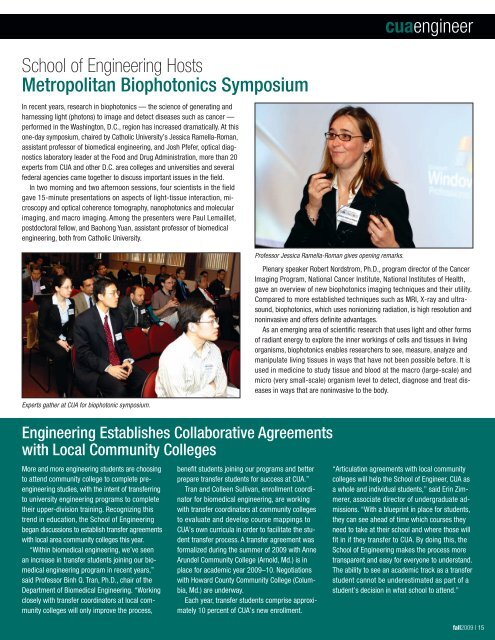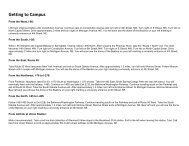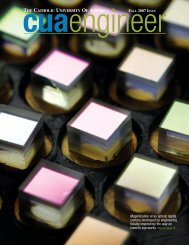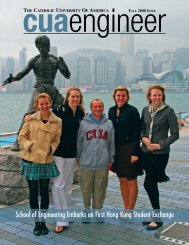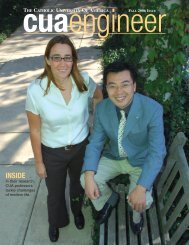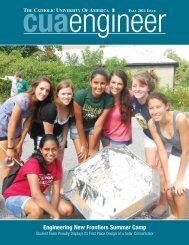cuaengineer - the School of Engineering - The Catholic University of ...
cuaengineer - the School of Engineering - The Catholic University of ...
cuaengineer - the School of Engineering - The Catholic University of ...
You also want an ePaper? Increase the reach of your titles
YUMPU automatically turns print PDFs into web optimized ePapers that Google loves.
<strong>cuaengineer</strong><br />
<strong>School</strong> <strong>of</strong> <strong>Engineering</strong> Hosts<br />
Metropolitan Biophotonics Symposium<br />
In recent years, research in biophotonics — <strong>the</strong> science <strong>of</strong> generating and<br />
harnessing light (photons) to image and detect diseases such as cancer —<br />
performed in <strong>the</strong> Washington, D.C., region has increased dramatically. At this<br />
one-day symposium, chaired by <strong>Catholic</strong> <strong>University</strong>’s Jessica Ramella-Roman,<br />
assistant pr<strong>of</strong>essor <strong>of</strong> biomedical engineering, and Josh Pfefer, optical diagnostics<br />
laboratory leader at <strong>the</strong> Food and Drug Administration, more than 20<br />
experts from CUA and o<strong>the</strong>r D.C. area colleges and universities and several<br />
federal agencies came toge<strong>the</strong>r to discuss important issues in <strong>the</strong> field.<br />
In two morning and two afternoon sessions, four scientists in <strong>the</strong> field<br />
gave 15-minute presentations on aspects <strong>of</strong> light-tissue interaction, microscopy<br />
and optical coherence tomography, nanophotonics and molecular<br />
imaging, and macro imaging. Among <strong>the</strong> presenters were Paul Lemaillet,<br />
postdoctoral fellow, and Baohong Yuan, assistant pr<strong>of</strong>essor <strong>of</strong> biomedical<br />
engineering, both from <strong>Catholic</strong> <strong>University</strong>.<br />
Experts ga<strong>the</strong>r at CUA for biophotonic symposium.<br />
<strong>Engineering</strong> Establishes Collaborative Agreements<br />
with Local Community Colleges<br />
More and more engineering students are choosing<br />
to attend community college to complete preengineering<br />
studies, with <strong>the</strong> intent <strong>of</strong> transferring<br />
to university engineering programs to complete<br />
<strong>the</strong>ir upper-division training. Recognizing this<br />
trend in education, <strong>the</strong> <strong>School</strong> <strong>of</strong> <strong>Engineering</strong><br />
began discussions to establish transfer agreements<br />
with local area community colleges this year.<br />
“Within biomedical engineering, we’ve seen<br />
an increase in transfer students joining our biomedical<br />
engineering program in recent years,”<br />
said Pr<strong>of</strong>essor Binh Q. Tran, Ph.D., chair <strong>of</strong> <strong>the</strong><br />
Department <strong>of</strong> Biomedical <strong>Engineering</strong>. “Working<br />
closely with transfer coordinators at local community<br />
colleges will only improve <strong>the</strong> process,<br />
benefit students joining our programs and better<br />
prepare transfer students for success at CUA.”<br />
Tran and Colleen Sullivan, enrollment coordinator<br />
for biomedical engineering, are working<br />
with transfer coordinators at community colleges<br />
to evaluate and develop course mappings to<br />
CUA’s own curricula in order to facilitate <strong>the</strong> student<br />
transfer process. A transfer agreement was<br />
formalized during <strong>the</strong> summer <strong>of</strong> 2009 with Anne<br />
Arundel Community College (Arnold, Md.) is in<br />
place for academic year 2009–10. Negotiations<br />
with Howard County Community College (Columbia,<br />
Md.) are underway.<br />
Each year, transfer students comprise approximately<br />
10 percent <strong>of</strong> CUA’s new enrollment.<br />
Pr<strong>of</strong>essor Jessica Ramella-Roman gives opening remarks.<br />
Plenary speaker Robert Nordstrom, Ph.D., program director <strong>of</strong> <strong>the</strong> Cancer<br />
Imaging Program, National Cancer Institute, National Institutes <strong>of</strong> Health,<br />
gave an overview <strong>of</strong> new biophotonics imaging techniques and <strong>the</strong>ir utility.<br />
Compared to more established techniques such as MRI, X-ray and ultrasound,<br />
biophotonics, which uses nonionizing radiation, is high resolution and<br />
noninvasive and <strong>of</strong>fers definite advantages.<br />
As an emerging area <strong>of</strong> scientific research that uses light and o<strong>the</strong>r forms<br />
<strong>of</strong> radiant energy to explore <strong>the</strong> inner workings <strong>of</strong> cells and tissues in living<br />
organisms, biophotonics enables researchers to see, measure, analyze and<br />
manipulate living tissues in ways that have not been possible before. It is<br />
used in medicine to study tissue and blood at <strong>the</strong> macro (large-scale) and<br />
micro (very small-scale) organism level to detect, diagnose and treat diseases<br />
in ways that are noninvasive to <strong>the</strong> body.<br />
“Articulation agreements with local community<br />
colleges will help <strong>the</strong> <strong>School</strong> <strong>of</strong> Engineer, CUA as<br />
a whole and individual students,” said Erin Zimmerer,<br />
associate director <strong>of</strong> undergraduate admissions.<br />
“With a blueprint in place for students,<br />
<strong>the</strong>y can see ahead <strong>of</strong> time which courses <strong>the</strong>y<br />
need to take at <strong>the</strong>ir school and where those will<br />
fit in if <strong>the</strong>y transfer to CUA. By doing this, <strong>the</strong><br />
<strong>School</strong> <strong>of</strong> <strong>Engineering</strong> makes <strong>the</strong> process more<br />
transparent and easy for everyone to understand.<br />
<strong>The</strong> ability to see an academic track as a transfer<br />
student cannot be underestimated as part <strong>of</strong> a<br />
student’s decision in what school to attend.”<br />
fall2009 | 15


